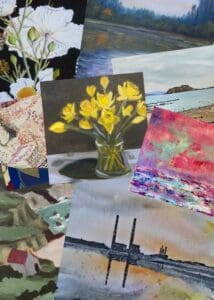Crafting a Winning Artist Statement: Tips for Articulating Your Vision
In the vibrant and ever-evolving world of art, one of the most important tools an artist can have in their arsenal is a compelling artist statement. Your artist statement is not just a description of your work; it’s an essential part of your artistic identity that communicates your vision, process, and inspirations to your audience, galleries, curators, and potential collectors. In this blog post, we’ll delve into the key elements of a winning artist statement and provide practical tips, examples, and templates to help you craft a statement that truly resonates with your artistic journey.
What is an Artist Statement?
An artist statement is a written description of your work that provides context to your art practice. It often accompanies your portfolio and serves as a bridge between your work and the viewer, offering insights into your creative process, themes, and influences. A well-crafted artist statement is concise yet informative, offering a glimpse into the mind of the artist and the meaning behind their work.
Why is an Artist Statement Important?
- Contextualizes Your Art: An artist statement helps to situate your work within a broader artistic context, explaining the themes, ideas, and processes that drive your practice.
- Engages Your Audience: It provides viewers with an entry point into your art, helping them to connect with your work on a deeper level.
- Supports Your Professional Presence: A strong artist statement enhances your professional image, making you more appealing to galleries, curators, and collectors.
- Guides Interpretation: While art is often open to interpretation, an artist statement can guide the viewer’s understanding, offering a clearer perspective on your intentions and artistic vision.
Essential Components of a Strong Artist Statement
To craft a compelling artist statement, you need to consider several key components:
1. Introduction to Your Artistic Vision
Begin with a brief introduction that encapsulates your artistic vision. This is your opportunity to make a strong first impression. Consider the following questions:
- What drives you as an artist?
- What is the overarching theme or message in your work?
- How does your art reflect your personal journey or worldview?
Example: “My work explores the complex relationship between nature and the urban environment. Through mixed media and organic materials, I seek to blur the lines between the constructed and the natural, challenging the viewer to reconsider their connection to the environment.”
2. Artistic Process
Explain your creative process. This section should describe how you create your work, including your techniques, materials, and the decisions you make along the way. It’s important to provide enough detail to give insight into your methods without overwhelming the reader.
Example: “I work primarily with oil paints, layering colors and textures to create a sense of depth and movement. My process begins with extensive research into natural forms, which I then abstract through a series of preliminary sketches before moving on to the canvas.”
3. Inspiration and Influences
Discuss the inspirations and influences that shape your work. This can include personal experiences, cultural references, historical contexts, or other artists. This section helps to contextualize your work within a broader artistic or cultural framework.
Example: “My art is heavily influenced by the works of abstract expressionists such as Mark Rothko and Helen Frankenthaler. Additionally, my childhood experiences in rural Ireland, surrounded by the ever-changing landscape, have deeply influenced my exploration of nature’s fleeting beauty.”
4. Thematic Exploration
Detail the themes you explore in your work. Whether your art is focused on social issues, personal narratives, or abstract concepts, clearly articulate the central themes that your work addresses.
Example: “The central theme of my work is the exploration of identity and memory. I am particularly interested in how personal and collective memories shape our understanding of the self, which I express through layered compositions and fragmented imagery.”
5. Conclusion and Future Directions
Conclude your artist statement by reflecting on your artistic journey and indicating where you see your work going in the future. This can include upcoming projects, new themes you plan to explore, or any shifts in your artistic practice.
Example: “As I continue to evolve as an artist, I am increasingly drawn to the interplay between digital technology and traditional media. My upcoming projects will focus on integrating these elements to explore new dimensions of perception and reality.”
Tips for Crafting a Compelling Artist Statement
1. Be Authentic
Your artist statement should be a reflection of who you are as an artist. Avoid using overly complex language or trying to emulate someone else’s style. Instead, write in your own voice and stay true to your unique perspective.
2. Keep It Concise
While it’s important to provide enough detail to convey your message, an artist statement should be concise. Aim for around 250-500 words. This allows you to capture the essence of your work without overwhelming the reader.
3. Write in the First Person
Using the first person helps to create a more personal connection with the reader. It allows you to speak directly about your experiences and perspectives.
4. Revise and Edit
Don’t be afraid to write multiple drafts of your artist statement. After writing your initial draft, set it aside for a day or two before revisiting it. This will allow you to view it with fresh eyes and make necessary revisions.
5. Seek Feedback
Share your artist statement with trusted colleagues, mentors, or friends. They can provide valuable feedback and help you identify areas that may need further clarification or improvement.
6. Stay Current
Your artist statement should evolve along with your practice. As your work develops, revisit and update your statement to reflect any new directions, techniques, or themes.
Templates to Get You Started
Here are a few templates to help you structure your artist statement. Feel free to modify them to suit your specific needs.
Template 1:
- Introduction: “My work centers around [theme/subject], where I explore [specific aspect] through [medium/technique].”
- Process: “I create my art by [briefly describe your process], utilizing [materials/techniques] to achieve [artistic goal].”
- Inspiration: “My inspiration comes from [influences], which have shaped my approach to [aspect of work].”
- Themes: “In my work, I address themes such as [theme], reflecting on [specific context].”
- Conclusion: “Moving forward, I intend to [future direction], continuing to explore [aspect] in new and innovative ways.”
Template 2:
- Introduction: “As an artist, I am fascinated by [subject/theme], which I express through [medium].”
- Process: “My creative process involves [describe process], allowing me to explore [artistic intention].”
- Inspiration: “My work is influenced by [inspirations], which inform my exploration of [theme/subject].”
- Themes: “Through my art, I explore [themes], questioning [aspect of work].”
- Conclusion: “In the future, I plan to delve deeper into [new direction], expanding my exploration of [theme/subject].”
Example Artist Statements
Here are a few examples of artist statements that effectively communicate the artist’s vision, process, and inspirations:
Example 1:
“My work is a visual exploration of the intersection between humanity and the natural world. I use photography and digital manipulation to create surreal landscapes that challenge our perception of reality. Inspired by the Romantic tradition and contemporary environmental issues, my work seeks to evoke a sense of wonder and urgency in the viewer.”
Example 2:
“As a ceramic artist, I am drawn to the tactile and transformative nature of clay. My work is inspired by the rhythms of the ocean and the organic forms found in nature. Through hand-building and wheel-throwing techniques, I create vessels that evoke the fluidity and strength of water, encouraging a meditative interaction with the piece.”
Example 3:
“My art practice is rooted in the exploration of cultural identity and migration. Using mixed media, I create intricate collages that reflect the fragmented nature of memory and the complexities of belonging. Influenced by my own experiences as a first-generation immigrant, my work is a dialogue between past and present, seeking to reconcile the spaces in between.”
Final Thoughts
Crafting a winning artist statement is an essential step in defining your artistic practice and communicating your vision to the world. Remember, your artist statement is not static; it should evolve as your work grows and changes. By following the tips and guidelines outlined in this post, you’ll be well on your way to creating an artist statement that truly resonates with your audience.
If you’re looking for additional resources, here are a few websites that offer valuable insights and tools for writing an artist statement:
Be sure to share your artist statement with your community and on social media to enhance your visibility. Don’t forget to use relevant hashtags and keywords to reach a broader audience!
For an Enhanced Audio Conversation of this post please visit our YouTube Channel here.
*For collaborations, art features, or inquiries, please contact us at [email protected]. Don’t forget to follow us on Instagram, Facebook, Twitter.
Disclaimer: The views and opinions expressed in this article do not necessarily reflect the official policy or position of Irish Artmart.
Irish Artmart – Your Gateway to Artistic Excellence.
Tips to Express Your Creative Vision – Irish Artmart Podcast




